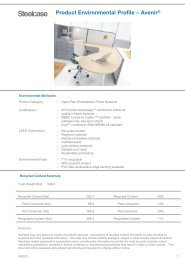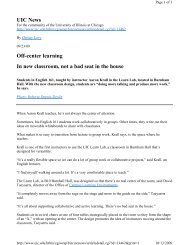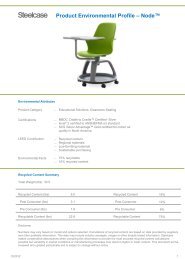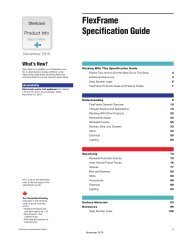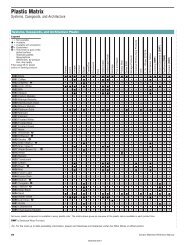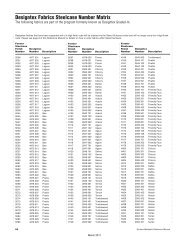Gen Y: India - Steelcase
Gen Y: India - Steelcase
Gen Y: India - Steelcase
Create successful ePaper yourself
Turn your PDF publications into a flip-book with our unique Google optimized e-Paper software.
<strong>Gen</strong> Y: <strong>India</strong><br />
©2011 <strong>Steelcase</strong> Inc.<br />
WorkSpace Futures
workspace futures<br />
Table of Contents<br />
Introduction..................................................................................... 2<br />
Our Process.................................................................................... 4<br />
Phase 1: Understand...................................................................... 6<br />
Phase 1: Understand — Key Findings.......................................... 13<br />
Phase 2: Observe.......................................................................... 14<br />
Phase 2: Observe — Key Findings............................................... 21<br />
Phase 3: Synthesize...................................................................... 22<br />
Phase 3: Synthesize — Key Shifts................................................ 23<br />
Phase 3: Synthesize — Design Principles.................................... 30<br />
Phase 4: Realize............................................................................ 32<br />
Phase 4: Realize — Spatial Concepts.......................................... 33<br />
In Closing...................................................................................... 44<br />
The Team....................................................................................... 45<br />
Notes/Bibliography....................................................................... 46<br />
360.steelcase.com <strong>Gen</strong>Y °<br />
1
introduction<br />
Introduction<br />
2<br />
360.steelcase.com <strong>Gen</strong>Y °
introduction<br />
Why study <strong>India</strong>?<br />
<strong>Steelcase</strong>’s WorkSpace Futures conducted a study of<br />
<strong>Gen</strong>eration Y in the US, in an effort to understand its impact<br />
on the workplace. Upon completion of that research, we began<br />
to wonder whether the insights we had uncovered here would<br />
also apply around the world. China and <strong>India</strong> immediately<br />
became likely candidates for further research, due to the<br />
sizes of their respective <strong>Gen</strong> Y populations.<br />
China & <strong>India</strong> have a combined population of 2.5 billion = 1/3<br />
of the global population<br />
In the US, <strong>Gen</strong> Y represents 70 million people between the<br />
ages of 10 and 30. <strong>India</strong>’s <strong>Gen</strong> Y population is 426 million of the<br />
same age; China’s equivalent population is 218 million, ranging<br />
from age 20 to 30. In addition, China and <strong>India</strong> have emerged<br />
as the second and fourth largest economies, respectively, in the<br />
world, representing an enormous opportunity for <strong>Steelcase</strong> and<br />
our customers.<br />
The graph below shows the <strong>Gen</strong> Y population for each country<br />
measured against the total population of that country.<br />
We learned from our US research that generations are defined<br />
by the key memories their members share, so we assumed that<br />
the <strong>India</strong>n and Chinese <strong>Gen</strong> Y populations would exhibit different<br />
characteristics than their US counterparts, but we didn’t know<br />
what those characteristics would be.<br />
What role would culture play in determining this generation’s<br />
values? What roles would politics and the economy play?<br />
What about technology? How would these areas influence this<br />
generation’s perceptions about work and workplace – and what<br />
might that workplace look like in 20 years?<br />
<strong>Steelcase</strong> WorkSpace Futures conducted a six month study<br />
of the <strong>Gen</strong> Y demographic in <strong>India</strong> starting in October of 2009.<br />
In <strong>India</strong>, though there is no Baby Boomer generation like in the<br />
US, generational definitions from the US are commonly followed,<br />
meaning there is <strong>Gen</strong> Y, and <strong>Gen</strong> X in <strong>India</strong> and those cohorts<br />
represent same year spans: <strong>Gen</strong> Y – born between 1980-2000,<br />
<strong>Gen</strong> X – born between 1964-1979. There is no Baby Boomer<br />
generation, but those born between 1947-1964 are known as<br />
the “Older <strong>Gen</strong>eration” or traditionals, and people born between<br />
1900-1946 are known as “Freedom Fighters”.<br />
In establishing our research in <strong>India</strong>, we employed as much as<br />
possible the same methodologies used in the US study. Our<br />
interview subjects represented a select population, being urban,<br />
educated, and employed primarily at multinational corporations<br />
and a few <strong>India</strong>n private companies. Gaining access to <strong>India</strong>n<br />
private companies was a little more difficult than multinational<br />
corporations. We believe this was due primarily to the lack of<br />
exposure to this type of research, a situation which we hope<br />
to resolve through a strategic rollout of the findings throughout<br />
<strong>India</strong>. We believe the findings contained in this book will be<br />
beneficial to our <strong>India</strong>n colleagues, as well as to those in the US.<br />
360.steelcase.com <strong>Gen</strong>Y °<br />
3
introduction<br />
Research Methods<br />
Our process<br />
Our Research Process<br />
At WorkSpace Futures, we follow a rigorous six-stage, human-centered design research<br />
process. We borrow heavily from techniques in ethnography and cultural anthropology.<br />
Through the research process, we have built a rich qualitative description of <strong>Gen</strong>eration Y<br />
in order to provide a meaningful context for our key research findings.<br />
4<br />
360.steelcase.com <strong>Gen</strong>Y °
introduction<br />
UNDERSTAND<br />
Learning from on/offline published material and experts regarding<br />
trends, business impact, and new techniques, etc.<br />
OBSERVE<br />
Collecting information firsthand through asking open-ended<br />
questions, observing people and processes, and engaging<br />
participants in co-creation activities to uncover new patterns<br />
of behaviors.<br />
SYNTHESIZE<br />
Recognizing patterns and anomalies from both secondary<br />
research and observation, allowing us to develop insights<br />
and new concepts.<br />
REALIZE<br />
Ideating solutions, through sketches, floor plans and strategies.<br />
This becomes the mode of communication for sharing our<br />
research findings.<br />
PROTOTYPE<br />
Converting solutions into prototypes enables us to elicit feedback<br />
from real users as we develop concepts from the Realize phase.<br />
This allows us to document evidence of progress and refine<br />
solution prototypes for higher chances of success.<br />
(<strong>Gen</strong> Y in Asia has not yet reached this stage of exploration.)<br />
MEASURE<br />
Developing meaningful measures for testing prototypes allows us<br />
to validate our solutions against identified user needs, for product<br />
design as well as space applications. Measurement activities<br />
can include pre- and post-occupancy surveys, time-lapse video<br />
observation, simulation exercises with users, and IRB-approved<br />
experiments with users.<br />
(<strong>Gen</strong> Y in Asia has not yet reached this stage of exploration.)<br />
360.steelcase.com <strong>Gen</strong>Y °<br />
5
understand<br />
Understand<br />
6<br />
360.steelcase.com <strong>Gen</strong>Y °
understand<br />
The big picture<br />
Understanding: Four categories<br />
The following pages are intended to provide<br />
a more detailed backdrop about <strong>Gen</strong> Y in <strong>India</strong><br />
through the filters of Culture, Politics, Economics,<br />
and Technology.<br />
Culture<br />
<strong>India</strong> is a multi-cultural and multi-religious society with a<br />
history that stretches over 7000 years across the many faith<br />
and social traditions of the world. Numerous empires have<br />
invaded <strong>India</strong> throughout its history and today <strong>India</strong> recognizes<br />
six major religions and 17 major languages. Many elements of<br />
<strong>India</strong>’s diverse culture – from meditation to cuisine – have had<br />
a profound impact across the world. 1, 2<br />
Traditional <strong>India</strong>n culture is defined by a relatively strict social<br />
hierarchy. From an early age, children are reminded of their roles<br />
in society. This is reinforced by the fact that many believe gods<br />
and spirits have an integral and functional role in determining<br />
their lives. Several inherited differences such as religion, caste,<br />
language and customs divide the culture and the country.<br />
For generations, <strong>India</strong> has observed the tradition of the joint<br />
family system in which extended family members – parents,<br />
children, spouses, offspring, etc. – live together. Usually,<br />
the eldest male member is the head in this family system.<br />
He makes all important decisions, and the hierarchy is nurtured<br />
and respected at family level, percolating into work and social<br />
life as well. <strong>India</strong>n society puts loyalty to the family ahead of<br />
loyalty to society.<br />
Though not the case in some urban areas, arranged marriages<br />
have been the tradition in <strong>India</strong>n society for many centuries.<br />
Strong social networks and respect for hierarchy has made<br />
these marriages work in a system where the financial and social<br />
backgrounds of families, their castes and even astrological<br />
compatibility are scrutinized. In <strong>India</strong>, marriage is considered<br />
sacred and the divorce rate is extremely low at about 1%.<br />
<strong>India</strong> celebrates a wide variety of religious holidays and<br />
festivals – over 29 during a calendar year – often characterized<br />
by colors, gaiety, feasts and a variety of rituals. Each regional<br />
style of cuisine – generally split into five geographic areas<br />
– is characterized by an assortment of dishes and cooking<br />
techniques, reflecting the varied demographics of the country.<br />
<strong>India</strong>n art, architecture and costumes vary greatly across the<br />
country, influenced immensely by local traditions, geography,<br />
resources and climate. In <strong>India</strong>, a person’s social status is<br />
symbolized by his or her attire. <strong>India</strong>n dress etiquette discourages<br />
exposure of skin or tight clothing.<br />
Though field hockey is <strong>India</strong>’s official national sport, cricket is the<br />
most popular. Its fans are fanatical and cricket is often referred to,<br />
tongue-in-cheek, as a religion.<br />
<strong>India</strong> is the world’s largest movie producing country. Bollywood,<br />
the Mumbai-based film industry, and other film centers, produced<br />
over 500 movies in 2009. Considered by many to be a country<br />
of dreamers, where optimism and prosperity are on the rise,<br />
most <strong>India</strong>ns aspire to the lifestyles and technology<br />
advancements of the West. 4<br />
<strong>India</strong> is founder of the “Non-Align Movement” and a nuclear<br />
power. 5 Today, <strong>India</strong> stands as the world’s largest democracy,<br />
second largest consumer base, third largest higher education<br />
system and fourth largest economy in the world with immense<br />
potential for entrepreneurship, research and innovation. 6<br />
Namaste is a common spoken greeting or salutation in <strong>India</strong>,<br />
meaning literally “that which is of God in me bows to that which<br />
is of God in you.” 3<br />
360.steelcase.com <strong>Gen</strong>Y °<br />
7
understand<br />
Politics<br />
With a population of 1.2 billion people, <strong>India</strong> is the world’s<br />
largest democracy.<br />
After gaining independence in 1947, <strong>India</strong> continued building<br />
a political framework based on the familiar British parliamentary<br />
system of rule, as well as their judicial, defense and educational<br />
structure. In <strong>India</strong>, the Prime Minister is identified as the head<br />
of the nation’s government, while the President is said to be<br />
the formal head of state and holds substantial reserve powers.<br />
Executive power is enforced by the government. The judiciary<br />
is independent of both the executive and legislative branches.<br />
As in the US, <strong>India</strong> possesses a federal form of government,<br />
however, the central government in <strong>India</strong> has greater power<br />
in relation to its states. 7<br />
<strong>India</strong> claims a multi-party system, supporting a number of<br />
national and regional parties. Since <strong>India</strong>’s independence,<br />
<strong>India</strong> has been ruled by the <strong>India</strong>n National Congress (INC) for<br />
48 years. Some regional parties, especially in south <strong>India</strong>, are<br />
deeply aligned to the ideologies of the area, unlike the national<br />
parties. Disparity between the ideologies of these local political<br />
parties leads to severely skewed allocation of resources between<br />
the states. The lack of homogeneity in the <strong>India</strong>n population has<br />
caused division between different sections of people based on<br />
religion, region, language, and race, leading to the rise of political<br />
parties with agendas catering to one (or a mix) of these groups. 8, 9<br />
The narrow focus of most parties, even in the central<br />
government and central legislature, sidelines national issues<br />
such as economic welfare and national security. Moreover,<br />
internal security is also threatened as incidences of party violence<br />
between opposing groups of people are a frequent occurrence. 10<br />
Economic issues like poverty, unemployment and development<br />
are the main issues that influence politics.<br />
Concern against organized crime does not tend to affect the<br />
outcomes of elections. On the other hand, there is often a strong<br />
criminal/political connection – in fact, many elected legislators<br />
have criminal cases against them. The economy of <strong>India</strong> was<br />
under socialist-inspired policies from the 1950s until the 1980s.<br />
The economy was subject to extensive regulation, protectionism,<br />
and public ownership, leading to pervasive corruption and<br />
11, 12<br />
slow growth.<br />
Historically,<br />
A 2005 study done by Transparency International (TI) in <strong>India</strong><br />
found that more than 50% of the people had firsthand experience<br />
of paying bribe or peddling influence to get a job done in public<br />
office. While many neighboring countries witness frequent coups,<br />
<strong>India</strong>n democracy has been suspended only once. Nevertheless,<br />
13, 14<br />
<strong>India</strong>n politics is often described as chaotic.<br />
Economics<br />
<strong>India</strong> was a country of great wealth, exotic<br />
spice trade and beautiful artistic expression. It lost its glory<br />
and richness during the British rule and became one of the<br />
poorest nations in the world. After many struggles, <strong>India</strong> is rapidly<br />
emerging as an economic world leader again. Ever growing since<br />
opening up for global trade in 1991, it has since become the<br />
fourth largest economy in the world. Economic reforms have led<br />
to less dependency on foreign investments, ever growing exports,<br />
and a huge, highly skilled and globally competent workforce.<br />
<strong>India</strong>’s rise to power has not gone unnoticed among world<br />
leaders. In the last six months of 2010, <strong>India</strong> was visited by all five<br />
members of the UN Security Council, with trade being the main<br />
topic in all cases. 15<br />
According to McKinsey Quarterly, optimism could be a key<br />
factor in <strong>India</strong>’s success, and a poll by McKinsey Global Surveys,<br />
recently stated that <strong>India</strong>n executives are more than twice as<br />
optimistic as those in the rest of the world. 16<br />
McKinsey Global Institute expressed in 2007 that <strong>India</strong>’s middle<br />
class will continue to grow, accounting for more than 40% of the<br />
population by 2025. 17 Current data project Asia accounting for<br />
55% of the global middle class by 2030 – up from the current<br />
25% – mostly from China and <strong>India</strong>.<br />
By the end of their fiscal year in March of 2011, it’s anticipated<br />
that <strong>India</strong> will have achieved an economic growth rate of<br />
approximately 9%. 18 Only a fraction of <strong>India</strong>’s success can<br />
be attributed to foreign interests, though. Many investors from<br />
within the country are also rising to great wealth. 48 new <strong>India</strong>n<br />
billionaires were listed on the Forbes Global List in 2009. No other<br />
country came close to matching that staggering number. Mukesh<br />
Ambani, the fourth richest billionaire in the world, explains that<br />
“I think that our fundamental belief is that growth is a way of life,<br />
and we have to grow at all times.” 19<br />
Growth in <strong>India</strong> has not been without struggle, though logistics<br />
is proving one of its greatest problems. The September 2010<br />
McKinsey Quarterly echoed the same thought “If current trends<br />
prevail, inefficiencies associated with poor logistics will increase<br />
from a current $45 billion to $140 billion in 2020, but a wellplanned<br />
infrastructure program could help <strong>India</strong> cut this waste<br />
by half.” 20<br />
<strong>India</strong>’s exports are currently growing at a rate of 23%. <strong>India</strong> is<br />
Asia’s largest outsourcing industry, with IT contracts from all over<br />
the world and is also becoming one of the largest auto industries.<br />
Almost 3000 multinational companies, over a third of which are<br />
US companies, have established their operations in <strong>India</strong>. In<br />
the past, there were restrictive policies against direct foreign<br />
investment, but since 1991, the government has encouraged it.<br />
With leading industrialists focused on increasing the efficiency<br />
21, 22, 23<br />
of <strong>India</strong>n logistics, <strong>India</strong> is poised for continued growth.<br />
8<br />
360.steelcase.com <strong>Gen</strong>Y °
understand<br />
Technology<br />
The history of science and technology in <strong>India</strong> runs handin-hand<br />
with the history of civilization, dating back to farm<br />
irrigation development in the Indus Valley in 4500 BC. Through<br />
the centuries, <strong>India</strong> remained at the forefront of technological<br />
advance with indoor plumbing in 2800 BC, standardized<br />
measurements in 2500 BC, astronomy in 1200 BC, and<br />
atomic theory in 100 BC.<br />
Mathematical, biological, and chemical technologies continued<br />
to advance in <strong>India</strong>, but couldn’t keep up with the advancements<br />
in Europe during the Renaissance. However, British colonial<br />
rule gave many <strong>India</strong>ns access to European educational<br />
systems, providing the basis for technological programs for<br />
an independent <strong>India</strong>. These strong programs allowed <strong>India</strong> to<br />
develop nuclear power back in 1958, and their nuclear energy<br />
is considered to be the safest in the world. Only a few years later<br />
in 1963, <strong>India</strong> began their space program and launched their first<br />
satellite in 1975. 24<br />
Modernization in the 20th century turned <strong>India</strong>’s technological<br />
advancements to more practical matters such as petroleum<br />
production and increasing food supply. Today, stability in the<br />
cities of <strong>India</strong> has led to further technology research and training.<br />
Due to the goals of <strong>India</strong>’s universities, the country now has the<br />
third-largest pool of technologically-trained personnel in the<br />
world. According McKinsey Quarterly, <strong>India</strong> is becoming a global<br />
technological hotspot due to “the desire to gain access to the<br />
country’s lower-cost, high-quality labor.” 25<br />
The IT sector in <strong>India</strong> has grown from a $100 million industry<br />
in 1992 to $40 billion in 2007. Over 160 institutions of science<br />
and technology produce 35,000+ post-graduates each year.<br />
These factors, combined with the expansion of wireless<br />
communications, are pushing <strong>India</strong> into the forefront of global<br />
technology. It’s estimated that <strong>India</strong> currently has over 700 million<br />
mobile phone customers – more than half of the total population –<br />
with growth at a million per month. In December 2009,<br />
over 19 million new customers subscribed wireless<br />
27, 28<br />
phone service.<br />
<strong>India</strong> also has the third-largest population of Internet users in the<br />
world, and it’s estimated that 40% of mobile subscribers access<br />
the web from their phones. Social networking has made a big<br />
impact, as well. 29<br />
Younger generations in <strong>India</strong> are the most sophisticated users<br />
of technology. These generations desire the latest and greatest<br />
technology tools like their global counterparts. <strong>Gen</strong> Y in<br />
particular, has awareness, access and “new money” and they<br />
want to use technology to make the difference; whether it’s the<br />
Internet, new software, iPhone apps, or social platforms such as<br />
Orkut, Facebook, YouTube, <strong>Gen</strong> Y in <strong>India</strong> are deeply interested<br />
in the use and development of technology. A recent Diversity Best<br />
Practices survey shows that 78% of <strong>Gen</strong> Y in <strong>India</strong> are interested<br />
in technology development – higher than that of <strong>Gen</strong> Y in<br />
the US or China. Technology is a principal part of the <strong>India</strong>’s<br />
30, 31<br />
<strong>Gen</strong> Y identity.<br />
Harsh Manglik, Accenture’s senior executive in <strong>India</strong> writes that<br />
<strong>India</strong> has a “GDP that has expanded by more than 7% annually<br />
for a decade,” but “<strong>India</strong> is in the throes of transformation.”<br />
Technological growth in <strong>India</strong> has surprising global potential,<br />
but is limited by the country’s social infrastructure. 26<br />
360.steelcase.com <strong>Gen</strong>Y °<br />
9
understand<br />
<strong>Gen</strong>erations<br />
Freedom Fighters:<br />
1900-46<br />
Traditionals:<br />
1947-64<br />
<strong>Gen</strong> X:<br />
1965-79<br />
<strong>Gen</strong> Y:<br />
1980-2000<br />
Who are the <strong>Gen</strong>erations in <strong>India</strong>?<br />
By definition, a <strong>Gen</strong>eration is a group a people who, based on<br />
age, share not only a chronological location in history, but also<br />
the experiences that accompany it. These common experiences,<br />
in turn, prompt the formation of shared beliefs and behaviors.<br />
Even though there’s no direct tie to the population booms of the<br />
US, <strong>India</strong> follows the US with generational titles and timeframes;<br />
meaning <strong>Gen</strong> Y in <strong>India</strong> = 1980-2000, <strong>Gen</strong> X = 1965-1979, etc.<br />
The 1940s and 1950s saw the birth of <strong>India</strong> as an independent<br />
nation. The upcoming generation at the time witnessed<br />
Mahatma Gandhi’s non-violent, civil disobedient campaign<br />
for independence, the end of the British Raj, and Gandhi’s<br />
assassination. <strong>India</strong> then shifted to a socialist economic model<br />
under Indira Gandhi’s leadership: nationalization of industries,<br />
public works, social reforms, and public investment in education.<br />
During the time <strong>Gen</strong> X were growing up, <strong>India</strong> saw Indira Gandhi<br />
killed by her bodyguards and succeeded by her son Rajiv Gandhi,<br />
who instituted a number of important reforms: loosened business<br />
regulations, lower restrictions on foreign investment/ imports, and<br />
reduced bureaucracy. He also led the country into the expansion<br />
of telecommunications, space programs, the software and IT<br />
sectors. Political conflict continued, and he was later killed.<br />
Members of <strong>Gen</strong> X in <strong>India</strong> developed a mental model patterned<br />
on a rich, vibrant democracy.<br />
The constraints of the caste system were giving way to the power<br />
of education, increasingly available for the best and brightest.<br />
In <strong>India</strong>, the late 1990s and 2000s saw the development of a large<br />
middle-class and increased demand for and production of many<br />
consumer goods and awareness and access to global goods.<br />
The <strong>India</strong>n economy grew under liberalization and reform policies,<br />
the country was stable and prosperous, and political power<br />
changed hands without incident. <strong>India</strong> became a prestigious<br />
educational powerhouse and respected source of IT talent.<br />
By 2008, 34 <strong>India</strong>n companies, and by 2009, 48 new billionaires<br />
were listed on Forbes global list.<br />
<strong>Gen</strong> Y’s in <strong>India</strong> share the generation’s global sense of<br />
immediacy, coupled with the excitement of being part of the<br />
country’s first wave of broad economic opportunity. As a result,<br />
young employees in <strong>India</strong> tend to share the rapid tempo of <strong>Gen</strong><br />
Y’s ambitions, but with a greater emphasis on financial reward<br />
as a desired outcome. Their mental model is heavily influenced<br />
by <strong>India</strong>’s rich, complex democracy - they easily accept diversity<br />
of opinion, making them strongly suited for global interaction. 32<br />
10<br />
360.steelcase.com <strong>Gen</strong>Y °
understand<br />
<strong>Gen</strong>erations: Memories Shared<br />
To better understand the dynamics of how generations develop characteristics –<br />
specifically the evolution of <strong>Gen</strong> Y characteristics – we conducted a unique<br />
timeline activity. We brought together people whose ages spanned three generations.<br />
We asked the participants to write down ten events that happened during their<br />
lifetimes, that impacted society. Note: The colors indicate which generations wrote<br />
down a particular event. The age ranges of the individuals who participated in this<br />
exercise are listed below.<br />
<strong>Gen</strong> Y (1980-2000)<br />
<strong>Gen</strong> X (1965-1979)<br />
Traditionals (1947-1964)<br />
360.steelcase.com <strong>Gen</strong>Y °<br />
11
understand<br />
Key Characteristics<br />
Key characteristics of<br />
<strong>Gen</strong> Y in <strong>India</strong><br />
a Open-minded<br />
a Energetic<br />
a Hard working<br />
a Tech savvy<br />
a Ambitious<br />
a Positive<br />
a Confident<br />
a Independent<br />
a Competitive<br />
a Impatient<br />
a Losing <strong>India</strong>n culture & values<br />
a Selfish<br />
a Quick Money<br />
12<br />
360.steelcase.com <strong>Gen</strong>Y °
understand<br />
Key Findings<br />
Characteristics & Resulting Behaviors.<br />
Open-minded, Positive<br />
Open to ideas and new possibilities<br />
Tech savvy, Impatient, Quick Money<br />
Deep interest and pride in owning state-of-the-art technology<br />
Optimistic about their work and the future<br />
Instant gratification<br />
Want lots of money, faster and quicker...and they like to spend<br />
Confident, Independent, Ambitious, Competitive<br />
Desire and drive for entrepreneurship and making a difference<br />
Keen sense of competition both regional and global<br />
Eager to prove they are not less than their global counterparts<br />
Feeling of national pride<br />
Losing <strong>India</strong>n culture & values, Selfish<br />
Passion for Hollywood and western lifestyle is in conflict<br />
with traditional values<br />
The shifting focus from Family First to Me First: My work,<br />
my friends, my things, and my world<br />
Energetic, Hard working<br />
Work is essential, and the focus is on process efficiency<br />
Always engaged in activities with peers: doing, sharing and<br />
discussing stuff<br />
360.steelcase.com <strong>Gen</strong>Y °<br />
13
observe<br />
Observe<br />
14<br />
360.steelcase.com <strong>Gen</strong>Y °
observe<br />
New Delhi<br />
Indore<br />
Consulting<br />
Bangalore<br />
Mumbai<br />
Hyderabad<br />
Chennai<br />
Technology<br />
Finance<br />
Media<br />
Manufacturing<br />
Service<br />
Sites Visited<br />
In conducting our three-pronged observation research, the<br />
Workspace Futures team travelled to six major cities accross<br />
six states, as shown in the map above.<br />
The companies studied were regional firms of various sizes,<br />
as well as Multi-National Companies (MNC).<br />
Company type<br />
no. of Participants<br />
...........................................................................................................<br />
Consulting 240<br />
Technology 163<br />
Finance 9<br />
Media 36<br />
Manufacturing 35<br />
Service 32<br />
...........................................................................................................<br />
TOTAL 515<br />
What we heard and saw<br />
Workplace Values: <strong>India</strong><br />
a Recognition and Reward<br />
a Growth Opportunity<br />
a Entertainment<br />
a Convenience<br />
a Sense of Achievement<br />
a Responsibility<br />
a Teamwork<br />
a Open Culture<br />
a Commitment<br />
a Low Stress<br />
In establishing our research in <strong>India</strong>, we employed the same<br />
methodologies used in the US study. As mentioned earlier,<br />
however, we discovered that in some instances people (especially<br />
from previous generations) were not very open in expressing their<br />
age, negative work experiences, or organizational issues. This<br />
may be due to the culture of respecting authority and hierarchy.<br />
But, we managed to collect data using different methods of<br />
triangulation which provide balanced perspective.<br />
360.steelcase.com <strong>Gen</strong>Y °<br />
15
observe<br />
What we heard and saw<br />
• Company-provided (mostly MNCs) transportation<br />
helps employees in reducing their stress by saving<br />
travel time and avoiding congested traffic<br />
• Traditionally common facilities are “property of all<br />
and responsibility of none,” ...MNCs are investing<br />
in keeping facilities clean and hygienic<br />
Work is 24/7 and global<br />
Learning & growth - in terms of peer-to-peer coaching<br />
and mentoring - are pursued as a means to further<br />
one’s career<br />
Shared workstations and group work settings encourage<br />
peer-to-peer interaction and teamwork<br />
Transparency for effectiveness and growth,<br />
not just information<br />
16<br />
360.steelcase.com <strong>Gen</strong>Y °
observe<br />
<strong>Gen</strong> Y are eager to express their identity<br />
Traditions, religious beliefs and cultural values are deeply<br />
embedded in the minds and hearts of people, and are<br />
present in modern work life<br />
Socialization and fun are becoming an integral part of<br />
work and work life...snacks, coffee, play, entertainment<br />
and relaxation<br />
• Inter- and intra-departmental competitions inspire<br />
employees to be competitive...winners are recognized<br />
and rewarded<br />
• Technology enhances company and employee<br />
identity, but is expensive and valuable...employees<br />
are aware and are taking good care of their technology<br />
MNC interiors are safe havens, offering a new identity<br />
to employees and providing refuge from the chaotic<br />
and polluted outside environment<br />
360.steelcase.com <strong>Gen</strong>Y °<br />
17
observe<br />
Engage<br />
Participatory design — Collage making:<br />
Participatory design activities are used to gain deeper insights<br />
from participants and engage them at both intellectual and<br />
emotional levels.<br />
Traditionally, when we ask questions, participants tend to<br />
respond intellectually – thinking it through with a response that<br />
provides explicit information. Observing participants’ behaviors<br />
and interactions leads to discoveries at a deeper level, which<br />
helps to understand unspoken, unarticulated and implicit needs.<br />
In participatory design activities, another level of information is<br />
revealed as participants create or make things. The social nature<br />
of this particular aspect of our research allows an individual’s<br />
personality, as well as deep feelings, to be reflected in the work<br />
he or she creates.<br />
The tool used was called Expression, proprietary software<br />
designed and created by WorkSpace Futures. The tool is intuitive<br />
and easy to use with a photo and word gallery from which<br />
subjects choose key words and images.<br />
For this research, we employed an activity called collaging.<br />
We asked each participant to create two collages describing:<br />
1. Their current work environment<br />
2. Their ideal work environment, by choosing photos<br />
and words from the galleries.<br />
There were no restrictions on the number of photos or words that<br />
they could choose. They could also move, resize and group the<br />
chosen photos and words as they desired. After the collages were<br />
created, participants were asked to explain the thinking behind<br />
their choices.<br />
18<br />
360.steelcase.com <strong>Gen</strong>Y °
observe<br />
Current Work Environment<br />
“Piled paper = lots of work, work is routine, can’t live<br />
without computer at work, so many emails. Worked<br />
here 1.5 yrs, already on my 3rd manager. Many<br />
changes, trying new things is fun for me. So many<br />
people on my global marketing team, so many emails.<br />
We work in cubicles. Career path.”<br />
Ideal Work Environment<br />
“Work-life balance, not such routine work. Linked<br />
more directly to customers, more leisure, more<br />
informal areas. More sharing with colleagues, more<br />
fun. Motivation, other than monetary, i.e. holidays, team<br />
building events. Change. Computer is the foundation<br />
of work process. Growth in terms of business &<br />
personal development.”<br />
360.steelcase.com <strong>Gen</strong>Y °<br />
19
observe<br />
Engage<br />
<strong>Gen</strong> Y : Current<br />
<strong>Gen</strong> Y : Ideal<br />
Top Word Choices : Fun, Knowledge<br />
Top Word Choices : Fun, Growth<br />
Top Image Choices :<br />
Top Image Choices :<br />
<strong>Gen</strong> X : Current<br />
<strong>Gen</strong> X : Ideal<br />
Top Word Choice : Flexibility, Creativity<br />
Top Word Choices : Creativity, Challenge<br />
Top Image Choices :<br />
Top Image Choices :<br />
20<br />
360.steelcase.com <strong>Gen</strong>Y °
observe<br />
Key Findings<br />
What We Learned<br />
Work<br />
• Money is important but type of work is even more important<br />
for achieving growth<br />
• Company brand and reputation of company matters a lot<br />
for <strong>Gen</strong> Y<br />
• Most of the work is still focused on business processes and<br />
software development and deployment but now slowly the<br />
focus is shifting to consulting, research, and innovation<br />
• Younger employees are desiring for impactful work,<br />
higher level of contribution and leadership roles<br />
• Abundant job opportunities and rising competition is leading<br />
to confident and highly competitive workforce<br />
Work-Life<br />
• They are challenged by lack of clear boundaries between<br />
work & life<br />
• Commuting is stressful due to traffic where they spend<br />
a whole lot of time<br />
• Family, friends and social relationships are of paramount<br />
importance but they do not get enough time<br />
• They expect entertainment and social events at work<br />
for themselves and their families<br />
• Food facilities, café’s, entertainment facilities and social<br />
engagement spaces at work are considered cool and trendy<br />
Worker<br />
• <strong>Gen</strong> Y are educated, open-minded, confident<br />
and competitive<br />
• Growing technology, trends and brand awareness<br />
• Most tech savvy compared to their global counterparts;<br />
they want to own latest and greatest technology tools<br />
• Entrepreneurship is on the rise and individuals are realizing<br />
the value of taking risk in order to grow<br />
• They are focused on RAPID growth and like to spend<br />
• They are focused on differentiation: How different, better,<br />
smarter and more influential am I compared to others...and<br />
the differentiation is achieved in terms of education, money,<br />
prestige, reputation, brands and technology<br />
Work Environment<br />
• Work environment is a prime attractor as it enhances employee<br />
image and offers prestige<br />
• It is a refuge from chaotic and polluted outside environments<br />
• Work environment is a leveler for employees coming<br />
from different financial, educational, social, and<br />
religious backgrounds<br />
• MNC work environments are not in harmony with local culture<br />
and climate and often are “out of context and out of place”<br />
• Hierarchy plays a role, where managers occupy private offices<br />
and employees are in open areas<br />
360.steelcase.com <strong>Gen</strong>Y °<br />
21
Synthesize<br />
Synthesize<br />
22<br />
360.steelcase.com <strong>Gen</strong>Y °
Synthesize<br />
Key Shifts<br />
1 2 3 4 5 6 7<br />
Local<br />
Global<br />
<strong>India</strong> was relatively isolated from the rest of the world. There was limited awareness of what was<br />
happening around the world and reach to outside markets – employers were concerned with fulfilling<br />
local needs only. Now, companies are focused on serving the global community. Employees are<br />
aware of what’s happening around the world, and understand how their companies’ efforts fit into<br />
the global economy.<br />
Local<br />
• Focus was on family & local community<br />
• Limited awareness & connection to events in<br />
other countries<br />
• Work was related to the needs & opportunities<br />
available locally<br />
Global<br />
• Focus is on global community<br />
• Broad awareness of events in other countries<br />
and their impact on oneself & <strong>India</strong><br />
• Work and opportunities are globally-oriented<br />
360.steelcase.com <strong>Gen</strong>Y °<br />
23
Synthesize<br />
Key Shifts<br />
1 2 3 4 5 6 7<br />
Service<br />
Core<br />
Competencies<br />
When MNCs first went into <strong>India</strong>, it was to outsource certain types of support labor, to save money.<br />
Going abroad for specialized education wasn’t possible for all. MNCs paid better, so educated people<br />
would take the jobs even though they were unchallenging. These workers were dispensable, since the<br />
jobs were unskilled. Now, MNCs are in <strong>India</strong> to take advantage of the high level of technical expertise:<br />
engineering, research, innovation. <strong>India</strong>ns no longer need to leave to get a specialized education,<br />
with new educational opportunities in <strong>India</strong>. MNCs now consider workers to be experts, not so<br />
easily replaced.<br />
Service<br />
• Employees seen as source of cheap labor<br />
• Education opportunities were limited; had<br />
to leave <strong>India</strong> for specialized education<br />
• Focus was on salary<br />
• Workers are dispensable<br />
core Competencies<br />
• Employees valued for expertise & capabilities<br />
• Many opportunities for higher education and<br />
careers exist in <strong>India</strong> and abroad; no need to<br />
leave <strong>India</strong> to advance<br />
• Focus is on developing one’s skills<br />
• Workers are experts<br />
24<br />
360.steelcase.com <strong>Gen</strong>Y °
Synthesize<br />
Key Shifts<br />
1 2 3 4 5 6 7<br />
Workplace is<br />
an Expense<br />
Workplace is<br />
an Investment<br />
Traditionally employers used to fit as many people as possible into a given space. They provided a<br />
desk and the minimum tools/equipment for each person to perform their job. The work environment<br />
had no relation to the company’s brand. All branding was customer-focused, and stopped in the lobby.<br />
Now, spaces are being designed to support not only the work, but also the workers. Everyone has the<br />
appropriate tools and equipment and supporting work settings to work effectively. Companies are using<br />
spaces to attract and retain the best workers and work environments reflect the company’s brand.<br />
Workplace is an expense<br />
• Number of people vs. square footage<br />
• Minimize the amount of tools and technology<br />
per worker<br />
• It’s about housing the worker<br />
• Environment has no relation<br />
to company’s brand<br />
Workplace is an Investment<br />
• Space designed to support the work<br />
and workers<br />
• Providing adequate tools and technology<br />
• It’s about attracting the worker<br />
• Environment reflects the company’s brand<br />
360.steelcase.com <strong>Gen</strong>Y °<br />
25
Synthesize<br />
Key Shifts<br />
1 2 3 4 5 6 7<br />
Inherited Identity<br />
Created Identity<br />
Traditionally, one’s identity was inherited from one’s family, occupation, ethnic culture, and region.<br />
Family identity was about status & power: how are we different from others? Cultural identity was defined<br />
by language, customs and geography. Now, identity is created by the individual – who do I want to be?<br />
Many of the values may be the same, e.g. money, status, but ways of obtaining them are different.<br />
Status gained, money earned and sphere of influence is created by type of work one does,<br />
reputation of the company one works for, the educational qualification, and impact of one’s work.<br />
Inherited Identity<br />
• Identity based on family, place of birth,<br />
family’s occupation<br />
• At workplace, getting hired depended<br />
on connections<br />
• Changing professions or roles was difficult<br />
and considered stupid<br />
Created Identity<br />
• Identity is created by the individual,<br />
based on education and capabilities<br />
• At the workplace, getting hired depends<br />
on skills and merit<br />
• Changing professions or roles to achieve<br />
growth is normal<br />
26<br />
360.steelcase.com <strong>Gen</strong>Y °
Synthesize<br />
Key Shifts<br />
1 2 3 4 5 6 7<br />
Job Security<br />
Growth<br />
People primarily were used to work for supporting the family. What one did wasn’t as important as<br />
having a steady income and wellbeing among family members. Retirement was secure and government<br />
jobs were desired. Now, people take jobs they believe will allow them to build a career. Growth is more<br />
important than job security; people will leave a job to advance career growth. Company retirement<br />
benefits aren’t a concern right now; the focus is on making money now to take care of oneself, one’s<br />
family and one’s own retirement. Companies that provide training and growth opportunities are desired.<br />
Job Security<br />
• Purpose of a job was to take care of the family<br />
• Job security was prime attractor<br />
• After-retirement benefits were expected<br />
(company takes care of me and my family)<br />
Growth<br />
• Purpose of a job is to create path for growth<br />
• Job security isn’t as important compared<br />
to growth<br />
• Focus is on making money now, not relying on<br />
after-retirement benefits (I am responsible for<br />
me and my family)<br />
• Looking for mentors in the workplace<br />
360.steelcase.com <strong>Gen</strong>Y °<br />
27
Synthesize<br />
Key Shifts<br />
1 2 3 4 5 6 7<br />
Work & Life<br />
Working & Living<br />
Traditionally, work dominated one’s life. At work, one’s performance was measured by the hours spent<br />
in the office. Employers only cared about getting the work done; employees were there to fulfill the<br />
boss’s vision. Now, life is becoming equally important, if not more so. Performance is measured by the<br />
quality of work, not the hours in the office. Employers care about their employees outside of work, as<br />
they provide transportation to help reduce commute-related stress, at times allowing employees to work<br />
from home. Entertainment, food and social events are offered at work for employees and their families.<br />
Work & Life<br />
• Number of hours is measurement of output<br />
• Overtime was expected and had to be<br />
performed in the office<br />
• Company didn’t care about worker beyond<br />
work hours<br />
• Company only cares about the work<br />
Working & Living<br />
• Quality of work is measurement of output<br />
• Overtime is expected, but may be performed<br />
at home<br />
• Company recognizes employees’ lives outside<br />
of work<br />
• Company actively supports work-life balance<br />
28<br />
360.steelcase.com <strong>Gen</strong>Y °
Synthesize<br />
Key Shifts<br />
1 2 3 4 5 6 7<br />
Connections<br />
Collaboration<br />
In the past, relationships were leveraged to form business connections. Titles and roles were more<br />
important than skills when forming teams. Teams performed the tasks assigned by their managers.<br />
Now, business relationships are formed based more on capabilities and expertise. Teams are formed<br />
based on individuals’ skills. Even though the work and projects are envisioned by managers, the team<br />
collaborates with the boss to enlarge the vision and goals of a project, and brainstorming and<br />
co-creation are becoming the norm.<br />
Connections<br />
• Business was based on relationships and<br />
connections<br />
• Teams brought together based on titles<br />
and roles<br />
• Hierarchy is dominant; boss delegates and<br />
teams work to complete the task<br />
Collaboration<br />
• Business is based on expertise and capabilities<br />
• Teams brought together based on skills<br />
and talents<br />
• Boss still delegates, but teams collaborate<br />
to enlarge the vision<br />
360.steelcase.com <strong>Gen</strong>Y °<br />
29
Synthesize<br />
Design Principles<br />
The following design principles are intended to help designers<br />
think about new ways to design work spaces in <strong>India</strong>, in order<br />
to leverage the skills brought by <strong>Gen</strong> Y.<br />
Instead of viewing this as a rule book telling them how to design,<br />
we encourage our clients to use this as a checklist, to remind<br />
them of key elements necessary to bring out the best of <strong>Gen</strong> Y.<br />
1 2<br />
Design for Identity<br />
• It’s about recognizing the individual<br />
• It’s about supporting individuals in the process of change<br />
Design for Growth<br />
• It’s about actively helping employees in their development<br />
• It’s about providing opportunities<br />
5 6<br />
Design for Creating Value<br />
• It’s about supporting differentiation through expertise<br />
Design for Global Competition<br />
• It’s about providing access to information<br />
• It’s about enhancing connections to the outside world<br />
• It’s about providing opportunities to learn from experts<br />
30<br />
360.steelcase.com <strong>Gen</strong>Y °
Synthesize<br />
3<br />
Design for Work-Life<br />
• It’s about providing flexibility and tools for working<br />
outside the office<br />
• It’s about creating social opportunities for families at work<br />
• It’s about acknowledging the personal life of employee<br />
4<br />
Design for Collaboration<br />
• It’s about transparency<br />
• It’s about providing for networking opportunities<br />
• It’s about promoting the expression of ideas<br />
7<br />
Design for Effectiveness<br />
• It’s about effectiveness, not efficiency<br />
• It’s about communicating the brand throughout the space<br />
(not stopping at the lobby)<br />
• It’s about demonstrating respect for the employee<br />
• It’s about supporting the need for breaks during the workday<br />
We must become the change we want to see.<br />
– Mahatma Ghandi<br />
360.steelcase.com <strong>Gen</strong>Y °<br />
31
ealize<br />
Realize<br />
32<br />
360.steelcase.com <strong>Gen</strong>Y °
ealize<br />
Spatial Concepts<br />
In the final phase of Realize, we conducted a design charette with<br />
individuals representing the product marketing, design, research<br />
and human resources departments.<br />
Over a two-day work session, the team generated ideas –<br />
sketches, strategies and policies – around the Key Shifts and<br />
Design Principles identified in our research. These ideas served<br />
as a provocative point of departure for new thinking on the next<br />
phase of work-life environments, tools and behaviors.<br />
1<br />
Design for Identity<br />
It’s about recognizing the individual<br />
It’s about supporting individuals in the process of change<br />
• Focused work settings<br />
• Informal, social and interactive environment<br />
• Entertainment and relaxation opportunities<br />
360.steelcase.com <strong>Gen</strong>Y °<br />
33
ealize<br />
1 Design for Identity: Continued<br />
• Opportunities for learning from others<br />
• Opportunities for connecting<br />
• Access to Information : organizational, process and work related<br />
34<br />
360.steelcase.com <strong>Gen</strong>Y °
ealize<br />
• Supporting individual needs<br />
• Opportunities for displaying personal achievements and work<br />
360.steelcase.com <strong>Gen</strong>Y °<br />
35
ealize<br />
2<br />
Design for Growth<br />
It’s about actively helping employees in their development<br />
It’s about providing opportunities<br />
• Formal and informal mentoring and learning opportunities<br />
• Opportunities for causal and intentional interactions<br />
36<br />
360.steelcase.com <strong>Gen</strong>Y °
ealize<br />
• Learning and collaboration with others<br />
• Exposure and access to information, knowledge and people<br />
360.steelcase.com <strong>Gen</strong>Y °<br />
37
ealize<br />
3<br />
Design for Work-Life<br />
It’s about providing flexibility and tools for working outside the office<br />
It’s about creating social opportunities for families at work<br />
It’s about acknowledging the personal life of employee<br />
• Casual relaxing environment that support mental and physical wellbeing<br />
• On-campus shopping opportunities<br />
• Cultural connections and connection to nature<br />
• Supporting personal needs: social environment, cricket, table tennis<br />
• Creating social opportunities for families<br />
38<br />
360.steelcase.com <strong>Gen</strong>Y °
ealize<br />
4<br />
Design for Collaboration<br />
It’s about transparency<br />
It’s about providing for networking opportunities<br />
It’s about promoting the expression of ideas<br />
• Transparency: organizational, process and people<br />
• Networking opportunities: social and informational<br />
• Opportunities for expressing ideas and thoughts<br />
• Learning from other’s thought processes<br />
• Networking opportunities<br />
360.steelcase.com <strong>Gen</strong>Y °<br />
39
ealize<br />
5<br />
Design for Creating Value<br />
It’s about supporting differentiation through expertise<br />
• Learning opportunities: information, people and processes<br />
• Opportunities for developing expertise and honing skill<br />
• Showcasing skills and learning from others<br />
• Learning from archived projects, and past successes<br />
40<br />
360.steelcase.com <strong>Gen</strong>Y °
ealize<br />
6<br />
Design for Global Competition<br />
It’s about providing access to information<br />
It’s about enhancing connections to the outside world<br />
It’s about providing opportunities to learn from experts<br />
• Access to information: physical and digital<br />
• Connection to people and knowledge: both from inside and outside the organization<br />
• Learning from Subject Matter Experts<br />
• Casual and purposeful interactions<br />
360.steelcase.com <strong>Gen</strong>Y °<br />
41
ealize<br />
7<br />
Design Effectiveness<br />
It’s about effectiveness, not efficiency<br />
It’s about communicating the brand throughout the space (not stopping at the lobby)<br />
It’s about demonstrating respect for the employee<br />
It’s about supporting the need for breaks during the workday<br />
• Connection to nature, regional culture and climate<br />
• Safe haven from surrounding chaos<br />
42<br />
360.steelcase.com <strong>Gen</strong>Y °
ealize<br />
• Connect with nature and regional culture<br />
• Calm, soothing environment<br />
360.steelcase.com <strong>Gen</strong>Y °<br />
43
in closing<br />
In Closing<br />
What We Learned<br />
What are you doing differently to attract and retain<br />
the best talent?<br />
Are you adopting the technologies that <strong>Gen</strong> Yers<br />
live with – and expect to use?<br />
Are you leveraging <strong>Gen</strong> Yers behaviors to foster<br />
collaboration and innovation?<br />
Are you prepared for the changing nature of work –<br />
and the worker of future?<br />
In this document we have identified some striking behavior<br />
patterns with <strong>Gen</strong>eration Y in <strong>India</strong> that we believe will impact not<br />
only the future of the <strong>India</strong>n workplace, but the concept of “global<br />
workplaces,” as well. Patterns in culture, politics, economics and<br />
technology, and their influence on the generations, have uncovered<br />
key shifts that are bound to become more pronounced as <strong>Gen</strong>eration<br />
Y fully assumes its place in the workforce.<br />
<strong>Gen</strong> Y in <strong>India</strong> embraces technology and is a true driver in this<br />
huge global market. Similar to the US, <strong>Gen</strong> Yers are considered<br />
open-minded, tech savvy, ambitious, and entrepreneurial. While<br />
sometimes seen as selfish, their initiative to compete, succeed<br />
and become independent would suggest a promising and<br />
optimistic future.<br />
It has been said that “man makes environment, and then environment<br />
makes man.” Environments that are in-sync with local culture,<br />
regional climate, global market forces, and are in tune with this<br />
generation’s desires. These environments should actively support<br />
international organizations in their efforts to attract, engage,<br />
and retain the talent of today and tomorrow. This young <strong>India</strong>n<br />
generation is poised and ready to take advantage of global work<br />
opportunities and make a real difference.<br />
As with the initial <strong>Gen</strong>eration Y work in the US, the question is –<br />
what do we do now? <strong>India</strong> and China make up one third of<br />
the Earth’s population. Size alone makes <strong>India</strong> a formidable cultural<br />
and economic force – a society literally bursting forth to become<br />
citizens of the world and influence the very nature of work and<br />
workplace design. The younger generation in <strong>India</strong> values much<br />
of western culture, but they are also passionate about <strong>India</strong>n<br />
culture and traditional values – resulting in a new fusion of<br />
Eastern and Western value systems.<br />
44<br />
360.steelcase.com <strong>Gen</strong>Y °
in closing<br />
The Team<br />
Core Members of the Research Team<br />
Sponsors<br />
Sara Armbruster<br />
<strong>Steelcase</strong> WorkSpace Futures<br />
& Corporate Strategy<br />
Uli Gwinner<br />
<strong>Steelcase</strong> Inc., Asia Pacific<br />
Advisors<br />
Ian Stewart<br />
<strong>Steelcase</strong> Inc., Asia Pacific<br />
Project Leads<br />
Sudhakar Lahade<br />
<strong>Steelcase</strong> WorkSpace Futures<br />
Melanie Redman<br />
<strong>Steelcase</strong> WorkSpace Futures<br />
Book Design and Editing<br />
Tim Carpenter & Ryan Mitchell<br />
Conduit Studios<br />
Acknowledgements<br />
The authors would like to acknowledge<br />
the contributions of:<br />
Praveen Rawal<br />
Naitry Saggu<br />
Vibhor Sharma<br />
Anne Davies<br />
Pinki Sen<br />
Tirthankar Basu<br />
Ravi Patel<br />
360.steelcase.com <strong>Gen</strong>Y °<br />
45
Bibliography<br />
Notes/Bibliography<br />
46<br />
360.steelcase.com <strong>Gen</strong>Y °
Notes<br />
Bibliography<br />
Culture, Page 7<br />
1. Culture of <strong>India</strong><br />
http://en.wikipedia.org/wiki/Culture_of_<strong>India</strong><br />
2. A Multicultural Society<br />
http://www.teachingenglish.org.uk/language-assistant/essentialuk/a-multicultural-society<br />
3. Better <strong>India</strong>: A Better World: by N. R. Narayana Murthy<br />
(May 1, 2010)<br />
4. 61 Interesting Facts about <strong>India</strong><br />
http://facts.randomhistory.com/2009/07/21_india.html<br />
5. Indira Gandhi on non-alignment: A collection of speeches<br />
by Indira Gandhi<br />
6. The future of Leadership: Conversations with Leaders about their<br />
Challenges and Opportunities. http://www.bcg.com/documents/<br />
file42391.pdf<br />
Politics, Page 8<br />
7. Politics of <strong>India</strong><br />
http://en.wikipedia.org/wiki/Politics_of_<strong>India</strong><br />
8. <strong>India</strong>’s Politics<br />
http://www.asianinfo.org/asianinfo/india/politics.htm<br />
9. Government and politics<br />
http://www.newworldencyclopedia.org/entry/<strong>India</strong>#Government_<br />
and_politics<br />
10. Improving governance<br />
http://www.transparencyindia.org/improving_governance.php<br />
11. Preparing for the next Asia<br />
https://www.mckinseyquarterly.com/Preparing_<br />
for_the_next_Asia_2452<br />
12. The World Fact book<br />
https://www.cia.gov/library/publications/the-world-factbook/<br />
geos/in.html<br />
13. Corruption perceptions index<br />
http://www.transparency.org/policy_research/surveys_indices/<br />
cpi/2010/rezsults<br />
14. Political Corruption in <strong>India</strong>: An Analysis<br />
http://www.southasiaanalysis.org/%5Cpapers<br />
3%5Cpaper219.htm<br />
Economics, Page 8<br />
15. Economy of india<br />
http://en.wikipedia.org/wiki/Economy_of_<strong>India</strong><br />
16. The organizational challenges of global trends:<br />
A McKinsey Global Survey<br />
https://www.mckinseyquarterly.com/The_organizational_challenges_of_global_trends_A_McKinsey_Global_Survey_2091<br />
17. Mapping Global Capital Markets: http://www.mckinsey.com/<br />
mgi/reports/pdfs/fifth_annual_report/fifth_annual_report.pdf<br />
18. The bird of gold: the rise of indias consumer market:<br />
http://www.mckinsey.com/mgi/reports/pdfs/india_consumer_<br />
market/MGI_india_consumer_full_report.pdf<br />
19. 75 Impeccable Business Advice from 39 Billionaires<br />
http://strategicbusinessteam.com/small-business-startupsadvice/75-impeccable-business-advice-from-39-billionaires/<br />
20. Economic Conditions Snapshot, September 2010: McKinsey<br />
Global Survey results<br />
https://www.mckinseyquarterly.com/Economic_Conditions_<br />
Snapshot_September_2010_McKinsey_Global_Survey_<br />
results_2672<br />
21. ‘<strong>India</strong>n economy expected to reach $ 6 trillion by 2020’<br />
http://articles.economictimes.indiatimes.com/2011-03-06/<br />
news/28660144_1_cent-gdp-growth-size-of-indianeconomy-trillion<br />
22. What’s Next for <strong>India</strong>: Beyond the Back Office<br />
http://www.bcg.com/documents/file14941.pdf<br />
23. <strong>India</strong>— From emerging to surging<br />
https://www.mckinseyquarterly.com/<strong>India</strong>_<br />
From_emerging_to_surging_1117<br />
360.steelcase.com <strong>Gen</strong>Y °<br />
47
Bibliography<br />
Technology, Page 9<br />
24. History of <strong>India</strong>n science and technology<br />
http://en.wikipedia.org/wiki/History_of_<strong>India</strong>n_<br />
science_and_technology<br />
25. Strengthening <strong>India</strong>’s offshoring industry<br />
https://www.mckinseyquarterly.com/Strengthening_<br />
<strong>India</strong>s_offshoring_industry_2372<br />
26. The Innovation Advantage<br />
http://www.accenture.com/us-en/research/institute-highperformance/Pages/insights-innovation-advantage.aspx<br />
27. <strong>India</strong> and China: Asia’s non-identical twins<br />
https://www.mckinseyquarterly.com/<strong>India</strong>_and_China_<br />
Asias_non-identical_twins_82<br />
28. China and <strong>India</strong>: The race to growth<br />
https://www.mckinseyquarterly.com/China_and_<strong>India</strong>_The_<br />
race_to_growth_1487?pagenum=4<br />
29. Making <strong>India</strong> a global hub<br />
https://www.mckinseyquarterly.com/Making_<strong>India</strong>_<br />
a_global_hub_167030. Ibid.<br />
30. A software subcontinent<br />
https://www.mckinseyquarterly.com/A_software_<br />
subcontinent_891<br />
31. What’s Next for <strong>India</strong>: Beyond the Back Office<br />
http://www.bcg.com/documents/file14941.pdf<br />
<strong>Gen</strong>erations, Page 10<br />
32. <strong>Gen</strong>erational Differences Between <strong>India</strong> and the U.S<br />
http://blogs.hbr.org/erickson/2009/02/global_generations_focus_on_in.html#<br />
Bibliography - Print & Digital Materials<br />
33. Making talent a strategic priority<br />
https://www.mckinseyquarterly.com/Making_talent_<br />
a_strategic_priority_2092<br />
34. Companies on the move: rising stars from rapidly<br />
developing economies are reshaping global industries<br />
http://www.bcg.com/documents/file70055.pdf<br />
35. Stimulating economies through fostering talent mobility<br />
http://www.bcg.com/documents/file41189.pdf<br />
36. <strong>India</strong>’s financial system: More market, less government<br />
https://www.mckinseyquarterly.com/<strong>India</strong>s_financial_system_<br />
More_market_less_government_1832<br />
37. Securing <strong>India</strong>’s place in the global economy<br />
https://www.mckinseyquarterly.com/Securing_<strong>India</strong>s_<br />
place_in_the_global_economy_2058<br />
38. Infosys: Born Global to Exploit the Skilled Workforce<br />
Advantage--A Profile of One of <strong>India</strong>’s Pioneering Multinationals<br />
http://hbr.org/product/infosys-born-global-to-exploit-theskilled-workfor/an/6736BC-PDF-ENG?Ntt=india+technology<br />
39. Leveraging Technology<br />
http://hbr.org/product/leveraging-technology/an/13065-<br />
PBK-ENG?Ntt=india+technology&referral=00269&<br />
cm_sp=endeca-_-spotlight-_-link<br />
40. China + <strong>India</strong>: The Power of Two. by Tarun Khanna.<br />
http://hbr.org/2007/12/china--india/ar/1#<br />
48<br />
360.steelcase.com <strong>Gen</strong>Y °
Bibliography<br />
Bibliography - print materials<br />
• 2x Imagining <strong>India</strong>: The Idea of a Renewed Nation,<br />
Nandan Nilekani<br />
• Billions of Entrepreneurs: How China and <strong>India</strong> Are Reshaping<br />
Their Futures--and Yours, Tarun Khanna<br />
• Chindia: How China and <strong>India</strong> Are Revolutionizing Global<br />
Business, Peter Engardio<br />
• Comparing Asian Politics: <strong>India</strong>, China, and Japan,<br />
Sue Ellen M. Charlton<br />
• Culture Shock! <strong>India</strong>: A Survival Guide to Customs and Etiquette<br />
(Culture Shock <strong>India</strong>), Gitanjali Kolonad<br />
• Doing Business in <strong>India</strong> For Dummies (For Dummies (Business &<br />
Personal Finance), Ranjini Manian<br />
• Getting China and <strong>India</strong> right: Strategies for Leveraging the<br />
World’s Fastest Growing Economies for Global Advantage,<br />
Anil K. Gupta and Haiyan Wang<br />
• In Spite of the Gods: The rise of Modern <strong>India</strong>, Edward Luce<br />
• <strong>India</strong>: A History, John Keay<br />
• <strong>India</strong> After Gandhi: The History of the World’s Largest<br />
Democracy, Ramachandra Guha<br />
• <strong>India</strong>: The Emerging Giant, Arvind Panagariya<br />
• <strong>India</strong> Unbound: The Social and Economic Revolution from<br />
Independence to the Global Information Age, Gurcharan Das<br />
• <strong>India</strong>’s Global Powerhouses: How They Are Taking on the World,<br />
Nirmalya Kumar, Pradipta K. Mohapatra, and Suj Chandrasekhar<br />
• <strong>India</strong>’s Store Wars: retail revolution and the Battle for the Next<br />
500 Million Shoppers, Geoff Hiscock<br />
• IT And the East: How China And <strong>India</strong> Are Altering the Future<br />
of Technology And Innovation (Gartner), James M. Popkin,<br />
Partha Iyengar<br />
• Speaking of <strong>India</strong>: Bridging the Communication Gap When<br />
Working With <strong>India</strong>ns, Craig Storti<br />
• Winning in the <strong>India</strong>n Market: Understanding the Transformation<br />
of Consumer <strong>India</strong>, Rama Bijapurkar<br />
360.steelcase.com <strong>Gen</strong>Y °<br />
49



